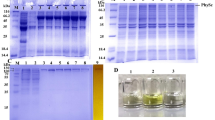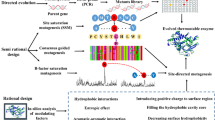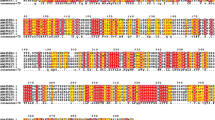Abstract
The production of 1, 3-propanediol (1, 3-PD) and 3-hydroxypropionaldehyde (3-HPA) by enzyme reaction has been a hot field, and glycerol dehydratase (GDHt) is the key and rate-limiting enzyme involved in their biosynthesis. The gldABC gene encoding GDHt was cloned from Klebsiella pneumoniae, and the activity of the corresponding proteins expressed extracellularly and intracellularly was 6.8 and 3.2 U/mg, respectively, about six and three times higher than that of the wild strain. The change of amino acids for the β subunit can adjust the length of the Co–N bond and affect the homolysis rate of the Co–C bond to change GDHt activity. The expression plasmid, pET-32a-gldAC (containing no gldB which encodes the β subunit of GDHt), was constructed to build the mutagenesis library to improve the GDHt activity. The binding models of glycerol dehydratase reactivation factor (GDHtR) with ATP, CTP, or GTP were simulated by semi-flexible docking, respectively, and there was almost no difference between them. This research provided the basis for studying the quantitative structure-activity relationships between GDHtR and its ligands, as well as searching inexpensive ligands to replace ATP. These results and methods are of great use in economical and highly efficient production of 3-HPA and 1, 3-PD by the enzyme method.





Similar content being viewed by others
References
Doleyres, Y., Beck, P., Vollenweider, S., & Lacroix, C. (2005). Production of 3-hydroxypropionaldehyde using a two-step process with Lactobacillus reuteri. Applied Microbiology and Biotechnology, 68, 467–474.
Saxena, R. K., Anand, P., Saran, S., & Isar, J. (2009). Microbial production of 1,3-propanediol: recent developments and emerging opportunities. Biotechnology Advances, 27, 895–913.
Biebl, H., Menzel, K., Zeng, A.-P., & Deckwer, W.-D. (1999). Microbial production of 1, 3-propanediol. Applied Microbiology and Biotechnology, 52, 289–297.
Liao, D.-I., Dotson, G., Turner, I., Jr., Reiss, L., & Emptage, M. (2003). Crystal structure of substrate free form of glycerol dehydratase. Journal of Inorganic Biochemistry, 93, 84–91.
Yamanishi, M., Yunoki, M., Tobimatsu, T., Sato, H., Matsui, J., Dokiya, A., Iuchi, Y., Oe, K., Suto, K., & Shibata, N. (2002). The crystal structure of coenzyme B12-dependent glycerol dehydratase in complex with cobalamin and propane-1, 2-diol. European Journal of Biochemistry, 269, 4484–4494.
Parikh, M. R., & Matsumura, I. (2005). Site-saturation mutagenesis is more efficient than DNA shuffling for the directed evolution of β-fucosidase from β-galactosidase. Journal of Molecular Biology, 352, 621–628.
Qi, X., Guo, Q., Wei, Y., Xu, H., & Huang, R. (2012). Enhancement of pH stability and activity of glycerol dehydratase from Klebsiella pneumoniae by rational design. Biotechnology Letters, 34, 339–346.
Qi, X., Sun, L., Luo, Z., Wu, J., Meng, X., Tang, Y., Wei, Y., & Huang, R. (2006). Rational design of glycerol dehydratase: swapping the genes encoding the subunits of glycerol dehydratase to improve enzymatic properties. Chinese Science Bulletin, 51, 2977–2985.
Toraya, T. (2002). Enzymatic radical catalysis: coenzyme B12-dependent diol dehydratase. Chemical Record, 2, 352–366.
Kajiura, H., Mori, K., Tobimatsu, T., & Toraya, T. (2001). Characterization and mechanism of action of a reactivating factor for adenosylcobalamin-dependent glycerol dehydratase. Journal of Biological Chemistry, 276, 36514–36519.
Mori, K., & Toraya, T. (1999). Mechanism of reactivation of coenzyme B12-dependent diol dehydratase by a molecular chaperone-like reactivating factor. Biochemistry, 38, 13170–13178.
Shibata, N., Mori, K., Hieda, N., Higuchi, Y., Yamanishi, M., & Toraya, T. (2005). Release of a damaged cofactor from a coenzyme B 12 -dependent enzyme: X-ray structures of diol dehydratase-reactivating factor. Structure, 13, 1745–1754.
Yanping Zhang, Z. R., Chenyu, D., Li, C., & Cao, Z. (2004). Effect of ATP addition on 1, 3-propanediol biosynthesis from glycerol by Klebsiella pneumoniae. The Chinese Journal of Process Engineering, 4, 567–571.
Zhi Rao, Y. Z., Shen, J., Li, C., & Cao, Z. (2004). Effect of addition of ATP on cell growth and 1,3- propanediol production of K. pneumoniae. Fine Chemical, 21, 413–417.
Li, W.-J., Fang, B.-S., Hong, Y., Wang, X.-X., Lin, J.-X., & Liu, G.-L. (2006). Cloning and expression of the genes encoding glycerol dehydratase reactivase and identification of its biological activity. Chinese Journal of Biotechnology, 22, 950–955.
Liao, D.-I., Reiss, L., Turner, I., Jr., & Dotson, G. (2003). Structure of glycerol dehydratase reactivase: a new type of molecular chaperone. Structure, 11, 109–119.
Zhang, G. L., Xu, X. L., Li, C., & Ma, B. (2009). Cloning, expression and reactivating characterization of glycerol dehydratase reactivation factor from Klebsiella pneumoniae XJPD-Li. World Journal of Microbiology and Biotechnology, 25, 1947–1953.
Kuntz, I. D., Blaney, J. M., Oatley, S. J., Langridge, R., & Ferrin, T. E. (1982). A geometric approach to macromolecule-ligand interactions. Journal of Molecular Biology, 161, 269–288.
Calvaresi, M., Hoefinger, S., & Zerbetto, F. (2012). Probing the structure of lysozyme-carbon-nanotube hybrids with molecular dynamics. Chemistry A European Journal, 18, 4308–4313.
Guo, J., Li, J., Zhang, Y., Jin, X., Liu, H., & Yao, X. (2013). Exploring the influence of carbon nanoparticles on the formation of β-sheet-rich oligomers of IAPP2 2-2 8peptide by molecular dynamics simulation. PLoS One, 8, e65579–e65579.
Kitjaruwankul, S., Boonamnaj, P., Fuklang, S., Supunyabut, C., & Sompornpisut, P. (2015). Shaping the water crevice to accommodate the voltage sensor in a down conformation: a molecular dynamics simulation study. The Journal of Physical Chemistry B, 119, 6516–6524.
Shen, J.-W., Wu, T., Wang, Q., & Kang, Y. (2008). Induced stepwise conformational change of human serum albumin on carbon nanotube surfaces. Biomaterials, 29, 3847–3855.
Shen, J.-W., Wu, T., Wang, Q., Kang, Y., & Chen, X. (2009). Adsorption of insulin peptide on charged single-walled carbon nanotubes: significant role of ordered water molecules. ChemPhysChem, 10, 1260.
Sun, X., Feng, Z., Hou, T., & Li, Y. (2014). Mechanism of graphene oxide as an enzyme inhibitor from molecular dynamics simulations. ACS Applied Materials & Interfaces, 6, 7153–7163.
Yang, L., & Gao, Y. Q. (2010). Effects of cosolvents on the hydration of carbon nanotubes. Journal of the American Chemical Society, 132, 842–848.
Zhang, L., Xiao, X., Yuan, Y., Guo, Y., Li, M., & Pu, X. (2015). Probing immobilization mechanism of alpha-chymotrypsin onto carbon nanotube in organic media by molecular dynamics simulation. Science Reports, 5, 9297–9297.
Zhiwei, F., Pearce, L. V., Xiaomeng, X., Xiaole, Y., Peng, Y., Blumberg, P. M., & Xiang-Qun, X. (2015). Structural insight into tetrameric hTRPV1 from homology modeling, molecular docking, molecular dynamics simulation, virtual screening, and bioassay validations. Journal of Chemical Information and Modeling, 55, 572.
Zuo, G., Huang, Q., Wei, G., Zhou, R., & Fang, H. (2010). Plugging into proteins: poisoning protein function by a hydrophobic nanoparticle. ACS Nano, 4, 7508–7514.
Padovani, D., Banerjee, R. and Klinman, J. P. (2009) A G-Protein Editor Gates Coenzyme B12 Loading and Is Corrupted in Methylmalonic Aciduria. Proceedings of the National Academy of Sciences of the United States of America, pp. 21567. National Academy of Sciences.
Daniel, R., Bobik, T. A., & Gottschalk, G. (1998). Biochemistry of coenzyme B12-dependent glycerol and diol dehydratases and organization of the encoding genes. FEMS Microbiology Review, 22, 553–566.
Tobimatsu, T., Azuma, M., Matsubara, H., Takatori, H., Niida, T., Nishimoto, K., Satoh, H., Hayashi, R., & Toraya, T. (1996). Cloning, sequencing, and high level expression of the genes encoding adenosylcobalamin-dependent glycerol dehydrase of Klebsiella pneumoniae. Journal of Biological Chemistry, 271, 22352–22357.
(2002) pET System Manual (10th Edition). Merck Company, Germany.
TORAYA, T., & FUKUI, S. (1977). Immunochemical evidence for the difference between coenzyme-B12-dependent diol dehydratase and glycerol dehydratase. European Journal of Biochemistry, 76, 285–289.
Toraya, T. (2000). Radical catalysis of B12 enzymes: structure, mechanism, inactivation, and reactivation of diol and glycerol dehydratases. Cellular and Molecular Life Sciences, 57, 106–127.
Brown, K. L., & Marques, H. M. (2005). Product stabilization in the enzymatic activation of coenzyme B 12 : a molecular modeling study. Journal of Molecular Structure: THEOCHEM, 714, 209–215.
Dölker, N., Maseras, F., & Siegbahn, P. E. (2004). Stabilization of the adenosyl radical in coenzyme B 12 -a theoretical study. Chemical Physics Letters, 386, 174–178.
Masuda, J., Shibata, N., Morimoto, Y., Toraya, T., & Yasuoka, N. (2000). How a protein generates a catalytic radical from coenzyme B 12 : X-ray structure of a diol-dehydratase–adeninylpentylcobalamin complex. Structure, 8, 775–788.
Zhang, Z.-G., Yi, Z.-L., Pei, X.-Q., & Wu, Z.-L. (2010). Improving the thermostability of Geobacillus stearothermophilus xylanase XT6 by directed evolution and site-directed mutagenesis. Bioresource Technology, 101, 9272–9278.
Hattori, M. E. (2012). Molecular mechanism of ATP binding and ion channel activation in P2X receptors. Nature, 485, 207–212.
Honda, S., Toraya, T., & Fukui, S. (1980). In situ reactivation of glycerol-inactivated coenzyme B12-dependent enzymes, glycerol dehydratase and diol dehydratase. Journal of Bacteriology, 143, 1458–1465.
Jiang, F., & Kim, S.-H. (1991). “Soft docking”: matching of molecular surface cubes. Journal of Molecular Biology, 219, 79–102.
Garg, A. D., Krysko, D. V., Verfaillie, T., Kaczmarek, A., Ferreira, G. B., Marysael, T., Rubio, N., Firczuk, M., Mathieu, C., Roebroek, A. J. M., Annaert, W., Golab, J., de Witte, P., Vandenabeele, P., & Agostinis, P. (2012). A novel pathway combining calreticulin exposure and ATP secretion in immunogenic cancer cell death. EMBO Journal, 31, 1062–1079.
Giorgio, V., von Stockum, S., Antoniel, M., Fabbro, A., Fogolari, F., Forte, M., Glick, G. D., Petronilli, V., Zoratti, M., Szabó, I., Lippe, G., & Bernardi, P. (2013). Dimers of mitochondrial ATP synthase form the permeability transition pore. Proceedings of the National Academy of Sciences of the United States of America, 110, 5887–5892.
Jeongmin ChoiTanaka, K. C. Q. Q. L. Y. L. G. (2014). Identification of a plant receptor for extracellular ATP. Science, 343, 290–294.
Hargreaves, D. C., & Crabtree, G. R. (2011). ATP-dependent chromatin remodeling: genetics, genomics and mechanisms. Cell Research, 21, 396–420.
Acknowledgments
This work was supported by the National Natural Science Foundation of China (No. 41176111 and No. 41306124), the State Key Program of the National Natural Science Foundation of China (No. 21336009), the Fundamental Research Funds for the Central Universities (No. 2013121029), the Foundation of South Oceanographic Research Center of China in Xiamen (No. 14GYY011NF11), and the Public Science and Technology Research Funds Projects of Ocean (No. 201505032-6).
Author information
Authors and Affiliations
Corresponding author
Ethics declarations
Conflict of Interest
The authors state that they have no competing interests.
Authors’ Contributions
WJ designed and supervised the experiments and drafted this manuscript. WJL performed the binding modes and revised the manuscript. YH performed gene cloning and expression in E. coli, and revised the manuscript. SZW constructed a mutagenesis library and revised the manuscript. BSF conceived the study, designed and supervised the experiments, and is the corresponding author. All authors have read and approved the manuscript.
Additional information
Highlights
• The specific activities of pET-32a-gldABC and pET-22b-gldABC were six and three times those of the wild type.
• An expression plasmid without gldB was built to construct a mutagenesis library.
• The binding modes of the GDHtR with ATP, CTP, or GTP, respectively, were simulated.
• The binding modes were almost no different basis for finding out inexpensive ligands to replace ATP.
Rights and permissions
About this article
Cite this article
Jiang, W., Li, W., Hong, Y. et al. Cloning, Expression, Mutagenesis Library Construction of Glycerol Dehydratase, and Binding Mode Simulation of Its Reactivase with Ligands. Appl Biochem Biotechnol 178, 739–752 (2016). https://doi.org/10.1007/s12010-015-1906-6
Received:
Accepted:
Published:
Issue Date:
DOI: https://doi.org/10.1007/s12010-015-1906-6




